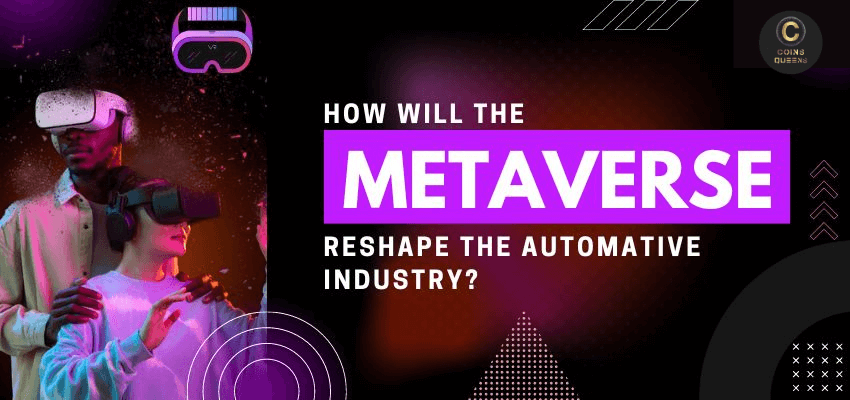The automotive industry is undergoing rapid transformation, fueled by digital auto sellers, shifting consumer needs, and increasing connected experiences. Technology is paving the way to safer roads with features like adaptive cruise control, collision prevention, and lane guidance. Innovations not only drive connected vehicles and autonomous mobility but also enhance the Web3 platform, the metaverse, and an emerging 3D network of virtual worlds.
Web3 is a user-controlled decentralized internet. Web3 is the user-owned environment that hosts the metaverse with its evolving galaxies of virtual 3D worlds. With rising operational costs and customer expectations, the metaverse is emerging as a critical enabler for accelerating growth, improving margins, and creating immersive experiences that deliver customer delight across multiple touch points.
Metaverse allows an autonomous vehicle driver to watch a movie, a dealer to sell cars from a “virtual” car lot, or an engineer to simulate how a new part will fit. The auto industry is getting a tantalizing taste of the metaverse at the massive CES [Consumer Electronics Show] technology show.
Read more: our metaverse development services
The automotive sector enters the era of metaverse:
The metaverse can aid in the design of new products as well as their testing in various environments. Alexandre Corjon, the head of innovation at French parts manufacturer Plastic Omnium, attended CES to investigate how his company could use the new technologies. According to him, the metaverse could allow him to show a client how a recycled material might react in a specific form and “demonstrate to the designer the effect that would have” on the vehicle. It may also demonstrate the superiority of a new product. The organization may also experiment with using the metaverse for meetings of its global management team, saving them the trouble of traveling in the first place.

Audi
Holoride, an Audi-backed start-up, is already selling a virtual reality headset designed specifically for rear-seat passengers. The system allows users to use a controller to watch a movie or play a video game, and it synchronizes VR content to the movements of the car to prevent nausea. Holoride’s new version, unveiled at CES, can be used in any vehicle.
BMW
BMW unveiled a concept car for future models that combines “the real and virtual worlds.” The system demonstrates a potential project that involves augmented reality images projected on the windscreen, such as transforming the entire windscreen into a screen to watch a movie or displaying the car’s speed and direction. With the Omniverse platform, the BMW Group and NVIDIA are developing a new approach to planning highly complex manufacturing systems.
Fiat
Fiat, the Italian automaker, launched a “metaverse store” where customers can use an online assistant to research, configure, and even purchase a vehicle. In addition, if a car breaks down, a technician could remotely instruct a user on how to make simple repairs.
Nissan
Nissan also entered the metaverse with its I2V Invisible to Visible AR concept, which debuted at CES 2019. The system highlights obstacles that may not be visible to the driver via a display inside the vehicle to enhance safety. The system allows individuals to appear as 3D avatars in the vehicle’s passenger seat as one friend to keep you company on a long drive or as a local guide who can answer questions and make recommendations. Nissan hopes to incorporate the technology into its vehicles by 2025.
Hyundai
Hyundai has collaborated with Unity to create virtually accessible 3D digital twins of their factories. Employees can assess modifications and adjustments to production lines during the early stages of planning. Hyundai unveiled its new concept called ‘Metamobility’ to pioneer Smart devices. The metaverse connection will expand the role of mobility to virtual reality (VR), eventually allowing people to overcome the physical constraints of movement in time and space. Hyundai Motor also shared its vision of how robots bridge the physical and virtual worlds. The users who make changes in the metaverse will get reflected in reality.
McKinsey
“Although metaverse remains years away, mobility stakeholders capture authentic business deals from the technologies developed to allow it,” McKinsey reported on the CES show. McKinsey ensures that consumers can virtually examine a realistic replica of a vehicle, opening its doors, feeling its seats, and accelerating onto a highway—just as they would with a real car if technologies continue to improve haptic devices that simulate touching sensation.
Valeo
According to Ghaya Khemiri, project manager for the Valeo, sensors on the outside of a vehicle will allow people who don’t like the feeling of a full headset to add landscapes to their virtual reality (VR) images. In addition, if sensors detect a person’s frustration, the system can help them relax. We had asked ourselves what we could offer for the enjoyment of users. The prototype system developed by the company would be used first by passengers or drivers taking a break when an electric vehicle is getting charged. When cars are fully self-driving, the driver may be able to operate them simultaneously.
Future of the automotive industry
In many ways, the auto industry is fully prepared to embrace the promise of the metaverse. One of its defining features is the ability to empower users to play a role in the customization of products, opening up new avenues for engagement with brands and product developers. Building, rebuilding, and modifying vehicles is already a thriving culture in the automotive industry.
According to the Specialty Equipment and Market Association (SEMA), the market for specialty equipment will be worth US$57.16 billion by 2024. Reports estimate that the Metaverse Advertising market will be worth $53.7 billion by 2024. With virtual billboards and sponsored content, metaverse advertising will be similar to in-game advertising. VR/MR headsets add new dimensions to understanding customer behavior. Advertising in the world raises brand awareness, particularly among the younger generation.
Virtual training can be delivered four times faster, while simulated training can achieve 75% retention and cost savings of up to 33%. 61% of millennials are interested in attending a live metaverse concert. As a result, there is enormous potential for organizing events, concerts, webinars, trade shows, and product launches in the metaverse by combining user experience and online capabilities. However, as the use of AR in consumers’ daily lives grows, so will adoption in automotive.
AR will then improve future entertainment experiences by superimposing content by repurposing car windows to display an entirely different world. These worlds could very well become a part of the metaverse.
Wrap up
The automobile industry is approaching its turning point: electric cars will be the new normal in the next decade, and self-driving cars aren’t far behind. The future necessitates traditional automakers to redesign their manufacturing practices and customer engagement strategies to sell to a diverse audience. The metaverse is undoubtedly a step in the right direction for automotive companies, as it effectively addresses these changes.
They can use digital twins and VR-enabled training to improve manufacturing and operational efficiencies. They can strengthen their marketing and sales programs by incorporating other components such as immersive virtual platforms, simulation setups, and metaverse to create highly personalized brand experiences at scale. Furthermore, as the metaverse grows in popularity, we can anticipate many more developments in this automotive domain.












